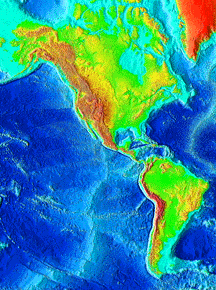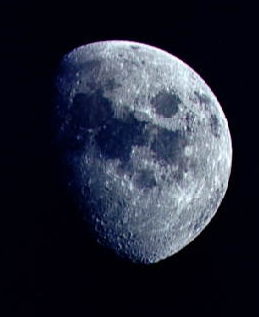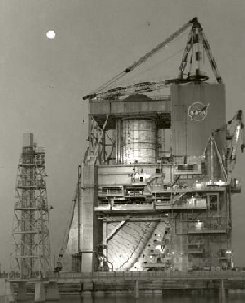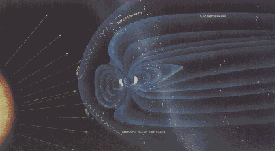This is a view of the Earth's magnetosphere.
Click on image for full size
Aris Multimedia Entertainment, Inc. 1994
The Moon's Magnetosphere
Unlike the Earth, which has a protective shield around it called the magnetosphere, the surface of the moon is not protected from the solar wind. This picture shows the magnetosphere surrounding the Earth, with the Earth a small object in the center.
A planet's magnetosphere is provided through its magnetic field. To create a magnetic field, a planet or moon must have magnetic material such has iron, which is warm enough to move around to form currents within the planet.
Over time planets and moons freeze completely through. It is possible that the moon has little magnetic field because its iron core has frozen solid. Further measurements via missions such as Lunar Prospector which supply information about the size and electrical conductivity of the lunar core will help scientists figure out the origins and evolution of the Moon and its magnetic field.
You might also be interested in:

How did life evolve on Earth? The answer to this question can help us understand our past and prepare for our future. Although evolution provides credible and reliable answers, polls show that many people turn away from science, seeking other explanations with which they are more comfortable.
...more
A planetary body, whether the body is a planet or a moon, cools slowly by radiating energy away into space. The warmth remaining inside a body controls what sort of surface activity, atmospheric activity,
...more
Although the Moon does not appear to have a magnetosphere surrounding it, it *is* a magnetic object in space. Scientists think that the magnetism of the Moon's surface is leftover from a time when the
...more
The Earth's one natural satellite, the Moon, is more than one quarter the size of Earth itself (3,474 km diameter), making the Earth-Moon system virtually a double-planet. Because of its smaller size,
...more
What is the diameter of the Moon in Kilometers? By how much is the Earth heavier than the Moon? How far is the Moon from the Earth? How old is the Moon? What is the internal structure of the Moon? I was
...more
Any successful theory must account for everything we know about the Moon now. Those things include the moon seems to be made of the same material as the Earth's upper mantle. the Moon has little or no
...more
The atmosphere of the Moon may come from a couple of sources, one source is outgassing or the release of gases such as radon, which originate deep within the Moon's interior. Gases are released from the
...more
In decades past is was accepted that the Moon contained no water. Moon rocks collected by Apollo astronauts (at lunar equatorial regions) contained no traces of water. Lunar mapping performed by the Galileo
...more












